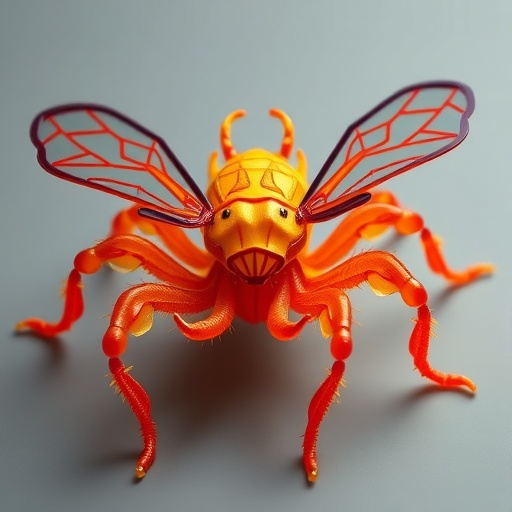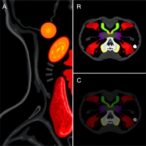
In a groundbreaking study set to transform our understanding of evolutionary biology, researchers have harnessed cutting-edge 3D printing technologies to unravel the complex adaptive landscape underlying Batesian mimicry. This pioneering work, led by Taylor, Watson, Skelhorn, and colleagues, brings unprecedented clarity to a classical puzzle: why do imperfect mimics persist in nature despite the presumed selective advantages of precise imitation? By generating meticulously crafted three-dimensional hoverfly-like models, the team has directly tested predator responses in a controlled yet ecologically relevant context, revealing nuanced insights into the selective pressures shaping mimicry.
At the heart of this study lies a sophisticated pipeline for creating a continuum of mimetic phenotypes. Unlike traditional approaches relying on natural insect specimens, the use of 3D-printed replicas allows unprecedented manipulation of visual traits with remarkable precision—albeit with some technological limitations such as wing transparency and movement fidelity. This innovation enabled the researchers to transcend the constraints of natural variation and generate intermediate and extrapolated forms that span the adaptive landscape of mimicry from near-perfect to moderately accurate phenotypes.
One of the key findings emerged from experiments designed to test the hypothesis that mimic accuracy is under intense selection from visually discerning predators. The team demonstrated that even mimics achieving high but not perfect accuracy remain subject to selective pressures favoring ever finer refinement. This result underscores the dynamic tension in mimicry systems, where partial deception may gain some reprieve but cannot fully escape the evolutionary drive towards precision, particularly under scrutiny by motivated avian predators.
.adsslot_73qPUVyupz{ width:728px !important; height:90px !important; }
@media (max-width:1199px) { .adsslot_73qPUVyupz{ width:468px !important; height:60px !important; } }
@media (max-width:767px) { .adsslot_73qPUVyupz{ width:320px !important; height:50px !important; } }
ADVERTISEMENT
Intriguingly, when the researchers generated intermediate phenotypes that blended features of two distinct model species, these “jack-of-all-trades” mimics showed no enhanced protection compared to mimics closely resembling a single model. This challenges prevailing notions that intermediate mimicry confers broader survival benefits by confusing predators with mixed signals, suggesting instead that mimicry systems prioritize accuracy to discrete models rather than generalized approximations.
The study goes further by disentangling the relative importance of various visual traits in predator discrimination. By independently varying features such as shape, pattern, size, and notably color, the researchers uncovered that size and particularly coloration are subject to stronger selective pressures than shape and pattern. This highlights the primacy of color cues in the predator’s visual processing of mimetic signals, a finding that may recalibrate how future research prioritizes trait focus within mimicry studies.
Importantly, the experimental design circumvented a long-standing hurdle in mimicry research: the infeasibility of fully controlled tests using live insects. Real specimens constrain manipulation and introduce confounding variables, whereas 3D-printed models offer a replicable and adjustable platform for dissecting predator-prey interactions with exceptional resolution. While these artificial stimuli are not perceived by birds as identical to real insects, behavioral trials confirmed that predators generalize their responses effectively, affirming the ecological relevance of the findings despite technological imperfections.
Moreover, this work propels mimicry research into new territory by simultaneously assessing predator responses across vastly different taxa, including invertebrate predators such as praying mantises. This comparative approach illuminates the “eye-of-the-beholder” hypothesis, demonstrating that variable visual systems among predators yield differential selection regimes. Some predators’ limited discriminatory ability allows a spectrum of moderately accurate mimicry phenotypes to enjoy protection, whereas more discerning predators impose stringent selection for higher accuracy.
This differential selection pressure provides a compelling explanation for the persistence of inaccurate mimicry in natural systems. Contrary to theories proposing that inaccurate mimics gain an active selective advantage, the study finds no experimental evidence supporting such claims. Instead, the observed persistence appears attributable to relaxed selection in some predator contexts, where moderate accuracy suffices for survival, thereby maintaining phenotypic diversity within mimicry complexes.
The research sheds light on how the interplay of predator communities—each with distinct perceptual sensitivities—and the salience of specific mimicry traits shape the evolutionary fate of mimetic phenotypes. In nature, prey are often subject to the combined selective pressures of multiple predator species, which may favor different traits or levels of mimicry accuracy. This multilayered selection landscape likely fosters a balance between highly accurate mimics favored by discerning predators and moderately accurate ones tolerated by less acute predators.
Beyond its immediate contribution to evolutionary theory, this study exemplifies a methodological leap forward. The integration of 3D printing technology with behavioral ecology experiments delivers a versatile toolkit for unraveling adaptive landscapes in other complex morphological traits, transcending the limitations of traditional techniques. By enabling fine-scaled manipulation of specific features, it opens avenues for experimentally probing selection in ways previously unachievable.
Another noteworthy aspect of this research is its potential to inspire future investigations incorporating multimodal sensory cues. While the current work focused predominantly on visual mimicry components, the authors acknowledge that sensory modalities such as olfaction and acoustic signals may contribute significantly to predator discrimination, particularly among invertebrate predators. Extending the 3D-printed stimuli framework to include these channels promises to deepen understanding of mimicry beyond the visual spectrum.
In sum, the combination of novel 3D-printed stimuli, a rigorous experimental framework, and cross-taxa predator testing yields a rich, nuanced picture of Batesian mimicry’s adaptive landscape. This approach clarifies why imperfect mimicry endures as a widespread phenomenon, identifying relaxed selection and predator-specific effects as key drivers. By dissecting which traits are critical to survival and how multiple predator perspectives shape mimicry, the study ushers in a new era of mimicry research grounded in mechanistic detail and technological innovation.
The broader implications of these findings extend not only across evolutionary biology but also into applied fields such as pest management and conservation, where understanding predator-prey dynamics can inform strategies for species protection or control. As researchers continue to refine 3D modeling and sensory integration, the capacity to experimentally simulate evolutionary scenarios promises to accelerate insights into the complex interplay of adaptation, selection, and ecological interactions.
Ultimately, Taylor, Watson, Skelhorn, and colleagues have opened an exciting frontier, demonstrating how multidisciplinary innovation can resolve enduring biological mysteries. Their work exemplifies the power of leveraging technology to dissect nature’s labyrinthine evolutionary puzzles, delivering clarity on an iconic example of natural selection and adaptation.
Subject of Research: The study investigates the adaptive landscape of Batesian mimicry by testing predator responses to 3D-printed insect-like stimuli with varying degrees of mimetic accuracy.
Article Title: Mapping the adaptive landscape of Batesian mimicry using 3D-printed stimuli
Article References:
Taylor, C.H., Watson, D.J.G., Skelhorn, J. et al. Mapping the adaptive landscape of Batesian mimicry using 3D-printed stimuli. Nature (2025). https://doi.org/10.1038/s41586-025-09216-3
Image Credits: AI Generated
Tags: 3D printing in evolutionary biologyadaptive landscape of mimicryadvanced biological modeling techniquesBatesian mimicry researchecological context in evolutionary studiesevolutionary advantages of mimicryhoverfly mimicry modelsimperfect mimics persistencephenotypic traits manipulationpredator-prey interactions studyselective pressures in mimicrytechnological innovations in biology



